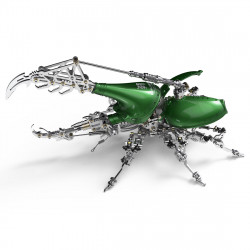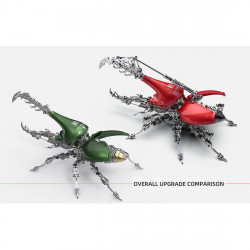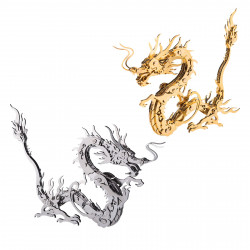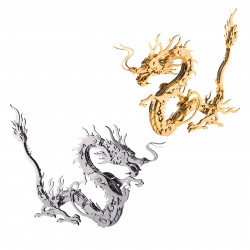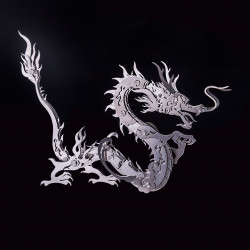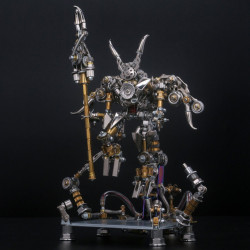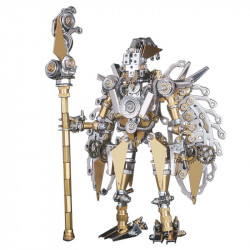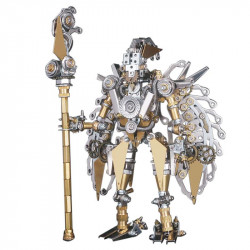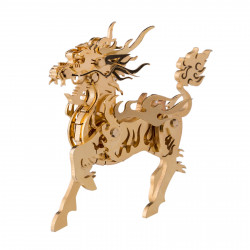Chinese Assembly Puzzle
A creature from Chinese mythology and legend is the dragon. In contrast to the enormous dragons of the West, the Chinese dragon symbolizes dignity, commanding presence, and unique abilities! But are myths genuinely authentic, and are there mythical animals like dragons? Or what terrestrial species will serve as its model?
Myths and legends, in the minds of many, are people's wonder at the unknowable, and items found in myths and legends can always be traced back to their real-world counterparts. This is also the case in actuality. Real-world animals and natural phenomena have been compared to many bizarre mythological creatures and gods.
However, not every myth and tale has a real-world counterpart. We cannot know, for instance, that a dragon is a real-life creature based only on its prototype! Furthermore, dragon existence defies the principles of contemporary physics, regardless of one's perspective!
The Mystery of Dragon's Flight
The Chinese dragon is wingless, unlike the enormous dragons of Western folklore. From a biological perspective, no creature on Earth—at least not that we know of—can fly without wings. But as we all know, the Chinese dragon defies the rules of physics by being able to soar over the nine heavens while riding the clouds and the mists.
Of course, some people believe that the rules of physics are not broken by dragons' capacity to fly. At least three methods by which dragons can become airborne comply with the current regulations of physics.
To float is the first approach. A dragon, for example, can float weightlessly in the air if its mass is minuscule compared to its enormous size, much like the hydrogen balloons we frequently see. However, explaining the dragon's exceptional agility and speed is tricky.
Another way is to glide. The dragon can soar in the skies by using its volume entirely as a paraglider, just like a paraglider can glide in the air! This kind of comment is certainly not advised, as the whole idea of gliding is to have a suitable height, and it is nonsensical that the dragon can only sometimes climb to a very high spot every time it flies!
The anti-gravity technique is the third. We know that the pull of gravity from the ground is why an item cannot fly. It will naturally be able to soar in the sky if it defies Earth's pull. Anti-gravity, however, goes beyond just rhetoric. It is currently not feasible to produce anti-gravity technologies with human technology. Is it possible for animals like dragons to independently evolve anti-gravity abilities? It doesn't seem reasonable.
The dragon's ability to summon rain and wind
The mythical dragon not only has the power to fly but can also summon rain and wind! Science is unable to explain this category either.
It is said in mythology that dragons can regulate rainfall. Dragons will create black clouds in the sky whenever it needs rain, and the rain will come quickly. They even have flexible control over how much rain falls. Scientists find this to be astounding!
You must understand that even though we can create artificial rain right now, there are still requirements. Artificial rainfall is unsuccessful if air moisture levels fall below a particular threshold. However, this idea is broken by the dragon's request for wind and rain, as though they could create rain out of thin air.
Some even believe that the dragon is an extraterrestrial craft, and that's why it can summon the wind and rain—it functions similarly to our manufactured rain. However, it is clear that the dragon's capacity to produce rain is omnipotent, and manufactured rainfall is not.
The dragon's residence
The dragon's home is the most crucial detail regarding the dragon's secret. Where is it going to reside?
Legend has it that dragons are marine animals. Their authority over all bodies of water worldwide derives from their inherent right to summon rain and wind.
However, based on its look, how come the dragon has feet even though it lives in the water? Nobody's feet seem to be doing anything in the water!
Furthermore, the dragon lacks the traits of a fish; it is a creature that breathes through its lungs, but how can a creature that depends on its lungs survive in water? Changing your breath is the obvious solution! The issue is the blatantly irrational lack of crucial documentation on dragons' ability to breathe underwater.
If the myths and tales are untrue, dragons exist on land, in some remote regions, and pertinent records exist. Nonetheless, despite human satellites being able to view practically the whole planet, there is still no information regarding the presence of dragons—at least not any that are on land.
Imagine for a moment if there truly is such a creature—whether on land or in the ocean—whose look completely defies the idea of evolution and whose skills defy accepted physics. Are prototypes found in the real world? This is not feasible!
As such, the dragon can only be a mythological monster, a creation of human imagination drawn from the wonders of nature by prehistoric people. That such a monster will exist is unthinkable!








